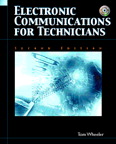


Electronic Communications for Professionals, First Edition
Formerly published by Pearson / Prentice Hall as Electronic Communications for Technicians.
Details about this Book

Tentative Table of Contents
Click a chapter for a preview of its content.
Important: The preview materials shown here do not reflect final product style and formatting.
- 1. Communication Systems
1-1 Communication Systems
1-2 A Simple Radio System
1-3 The Need for Modulation
1-4 A Practical Radio System
1-5 The Radio Frequency Spectrum
1-6 Digital Communications
1-7 How to Troubleshoot Systems - 2. Signal Analysis
2-1 Two Domains
2-2 Complex Waveforms
2-3 Noise Sources
2-4 Signal to Noise Ratio and Noise Figure
2-5 Noise Reduction Techniques
2-6 Fourier Series for Common Waveforms - 3. Amplitude Modulation
3-1 Generating an AM Signal
3-2 Measuring AM Signals in the Time Domain
3-3 Frequency Domain AM Analysis
3-4 Power and Efficiency
3-5 Spectrum Analyzer Measurements
- 4. AM Transmitters
4-1 Low and High Level Transmitters
4-2 Oscillator Theory
4-3 Three Oscillators
4-4 Crystal Controlled Oscillators
4-5 RF Amplifiers
4-6 RF Modulators
4-7 High Level Transmitter Circuit Analysis
4-8 Measuring Transmitter Performance
4-9 Troubleshooting Transmitters - 5. AM Receivers
5-1 Receiver Operation
5-2 AM Detection
5-3 The TRF Receiver
5-4 The Superheterodyne Receiver
5-5 Superheterodyne Receiver Circuit Analysis
5-6 Integrated Circuit Receivers
5-7 Alignment of Receivers
5-8 Troubleshooting Receivers
- 6. Single Sideband Systems
6-1 SSB Versus AM: Types of Sideband Signals
6-2 SSB Signal Generation: Filter Method
6-3 SSB Signal Generation: Phasing and DSP Methods
6-4 Frequency-Agile SSB Transmitters
6-5 SSB Receivers
6-6 SSB Transceivers
- 7. Systems for Frequency Generation
7-1 The Phase Locked Loop
7-2 PLL Synthesizers
7-3 How Software Controls a PLL Synthesizer
7-4 DDS Synthesizers
7-5 A Complete Frequency Synthesizer
7-6 Troubleshooting Frequency Synthesizers
- 8. Frequency Modulation: Transmission
8-1 A Simple FM Transmitter
8-2 FM Signal Analysis
8-3 Frequency Modulated Oscillators
8-4 Three FM Transmitters
8-5 Special Topics
8-6 A Simple FM Broadcast Transmitter
8-7 FM Stereo and SCA Systems
8-8 Measuring the Performance of FM Transmitters
- 9. FM Receivers
9-1 FM Superheterodyne Receivers
9-2 Detection of FM Signals
9-3 A Complete FM Receiver
9-4 Synthesized FM Receivers
9-5 FM Stereo and SCA Decoding
9-6 Alignment of FM Receivers
9-7 Troubleshooting FM Receivers
- 10. Television
10-1 Analog Television Principles
10-2 The Analog Video Signal
10-3 TV Receiver Operation
10-4 Color Television
10-5 High Definition Television (HDTV)
10-6 Troubleshooting TV Receivers
- 11. Transmission Lines
11-1 Basic Construction of Transmission Lines
11-2 Electrical Characteristics of Transmission Lines
11-3 Impedance Mismatches and Standing Waves
11-4 Impedance Matching Devices
11-5 Introduction to the Smith Chart
11-6 Troubleshooting Transmission Lines
- 12. Antennas and Wave Propagation
12-1 Electrical and Electromagnetic Energy
12-2 The Dipole and Marconi Antennas
12-3 Directional Antennas
12-4 Special Antennas
12-5 Antenna Troubleshooting and RF Safety
12-6 Wave Propagation
12-7 Link Budgets
- 13. Microwave Communication Systems
13-1 Microwave Construction Techniques
13-2 Microwave Transmission Lines
13-3 Microwave Oscillators
13-4 Microwave Amplifiers
13-5 Pulse and Doppler Radar Systems
- 14. Telephony and Cellular Networks
14-1 The System View
14-2 The Local Loop: Operation, Signaling, and Telephone Circuitry
14-3 Switching and Encoding: PCM
14-4 Wireless Telephony: AMPS and PCS
14-5 Special Topics: Caller ID, DSL, Voice over IP
- 15. Introduction to Data Communications
15-1 Nature of Digital Data
15-2 Network Topologies
15-3 Modems and Digital Modulation Techniques
15-4 Asynchronous Data and UARTs
15-5 Error Detection and Correction
15-6 The RS232/EIA232 Interface Standards
- 16. Networking Fundamentals
16-1 Network Hardware and Media
16-2 The ISO/OSI Model
16-3 The Internet and Internet Protocol (IP) Addressing
16-4 IP Addressing, Subnets, and Gateways
16-5 DHCP and ARP
16-6 Transport: TCP and UDP
16-7 Troubleshooting Networks
- 17. The Global Positioning System
17-1 Satellites and Orbits
17-2 How GPS Works
17-3 GPS Segments and Navigation Signal Processing
17-4 Reducing Position Error: Enhanced GPS
17-5 Troubleshooting GPS Installations
- 18. Fiber Optic and Laser Technology
18-1 Fiber Optic Construction and Operation
18-2 Propagation Modes and Dispersion
18-3 Light Wave Sources and Modulation Circuits
18-4 Light Wave Detection
18-5 Troubleshooting Fiber Optic Systems
- 19. Commercial and Public Service Communications Systems (* New proposed chapter *)
19-1 Commercial System Components, and Concepts
19-2 Narrow-band FM Equipment and Standards
19-3 Digital Equipment and Standards
19-4 Trunked and Networked Systems
19-5 Special Topics: Antennas, Diplexors, Duplexors, Grounding, and Performance Benchmarking
19-6 Troubleshooting Commercial Systems
- Appendix A: Decibels
- Appendix B: Bipolar Transistor Fundamentals
- Appendix C: Amateur Radio Communications
- Appendix D: Well Known TCP and UDP Port Numbers
- Appendix E: ASCII, EBCDIC, and Unicode Character Sets
- Glossary
- Your name and e-mail return address
- Your institution's name, your job title, telephone number, and department
- The course catalog and/or class section numbers where you anticipate using the text, and the number of students anticipated in each section

How do I Adopt this Text?
To adopt the textbook, simply contact us for a quote and provide the following information:
In return, we will provide you a written quotation that you may use within your organization to initiate a purchase order with us. We'll also be happy to contact you directly if you have any questions. It's that simple! Your electronic books will be available within two weeks of your order submission. (Please note that the Third Edition is planned to be released in July 2017.)

